THE MOTION
Page 22

If you've noticed an error in this article please click here to report it so we can fix it.
The wording of the RHA motion provoked a lively debate. The original motion suggested the government review 25.25m trucks, But Stan Robinson observed: "25.25m counts out my option straightaway. There are lots of members who would like to see two trailers run on restricted routes and at restricted times."
In response, the wording was changed to "larger, heavier trucks", which became "longer/ heavier trucks". Then logistics expert Alan McKinnon pointed out: "The government won't countenance heaviertrucks per se. You won't succeed in getting more weight unless they are also longer. Therefore you need to say 'longer and heavier'."
Annie Preston believed the term 'heavier' should be taken out entirely; after all, many of the operators who would benefit from this would do so from cube not weight. A recent TRL (Transport Research Laboratory) survey, according to Brian Smith of Volvo, suggested the average payload in a 44-tonner was just 17 tonnes
LHV advantages
George Inch, MD of DHL Container Logistics, listed several advantages of LHVs. They included: • 32% fewer trips • 15% less fuel
• 15% less CO2emissions
• 20% fewer heavy vehicles • 20% less road wear • 32% overall cost savings.
The session was headed 'Challenging congestion'. However, as McKinnon pointed out, trucks contribute very little to congestion and therefore taking trucks off the road has a limited effect on congestion.






















































































































































































